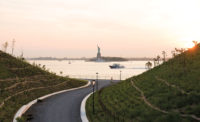Five design teams presented competing visions for a park on Governors Island at a public forum in New York City last week. Although roughly 350 people attended, they were a subdued crowd and only 40 returned comment sheets, underlining one of the Governors Island Preservation and Education Corporation’s (GIPEC) biggest challenges—how to make New Yorkers care about the relatively unknown, 172-acre landmass located a seven-minute ferry ride from the southern tip Manhattan.
“A grand total of probably 50,000 people have ever been on the island who were not members of the military forces and their families,” Leslie Koch, GIPEC’s president, said of the former Coast Guard facility, which was given to the city in 2003. GIPEC initiated a design competition last year that asked architects and designers to develop concepts for the island’s open space that would boost the number of visitors. Proposals from the five finalists were unveiled last month.
Field Operations and WilkinsonEyre propose a wide, circular promenade with a large, undulating meadow in the middle, and shell-shaped buildings for different programmatic elements. Hargreaves Associates and Michael Maltzan Architecture propose a “necklace” around the island, formed by multiple paths anchored by buildings that light up as beacons at night. REX and Michel Desvigne Paysagistes suggest imposing a Jeffersonian grid that would allow for flexible development at the edges and a garden at the center where visitors could get their hands dirty. West 8, Rogers Marvel Architects, and Diller Scofidio + Renfro propose circulation routes based on the markings of a butterfly wing, and a lush landscape “that’s as green as broccoli,” said West 8’s Adriaan Geuze, including artificial hills built from the waste of demolished buildings. WRT and Urban Strategies envision a multi-faceted park that brings water deep into the island.
Many of the people who submitted questions focused on how the island can attract developers and investors to become financially self-sufficient—which GIPEC itself has struggled with—while others asked designers what first steps they would take to implement their ideas.
“We think GIPEC needs to build a large constituency,” responded REX’s Joshua Prince-Ramus. “The first thing we would recommend is to start razing buildings just to put people into a panic that something is happening, to get them interested and involved.”
Field Operations’ James Corner suggested starting with the promenade. “We believe that if you build a place that has physical, aesthetic, and experiential characteristics that are just extraordinary, then you will procure extraordinary forms of development and investment.”
Of course, it might be early for such talk because final plans might bare little resemblance to these initial concepts. “We were going to wear T-shirts that said: ‘We’re choosing a team, not a scheme,’” Koch said. “It’s like dating. You’re choosing a partner.” The proposals can be viewed online at park-centeroftheworld.org, as well as at New York’s Center for Architecture and on Governors Island itself. GIPEC is soliciting public feedback. A jury will recommend a winning team, or teams, later this summer.
|




Post a comment to this article
Report Abusive Comment